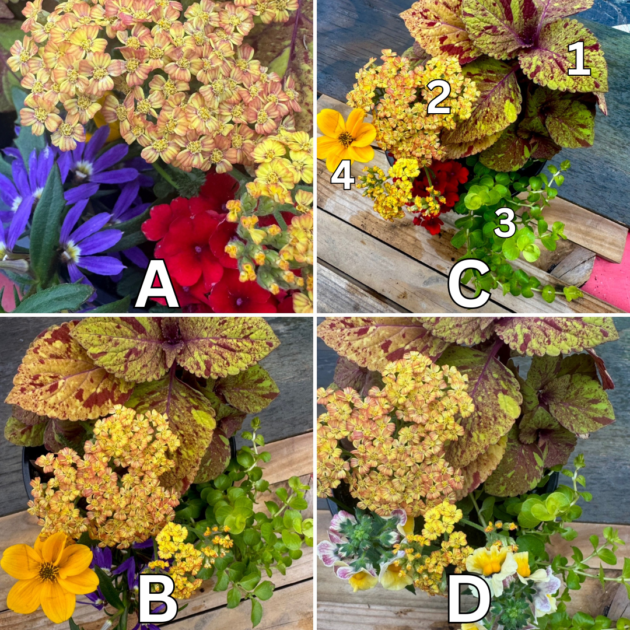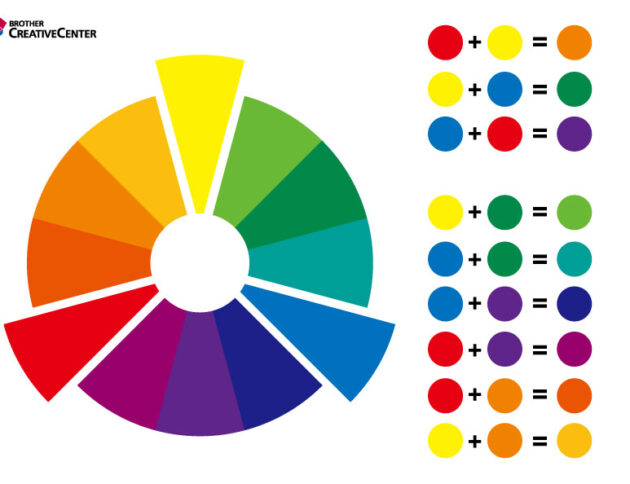March 27, 2025


Do you struggle with ornamental container designs? Landscape designs? Or are you looking to change up an older design with a fresh palette of colors? We have hundreds of plants and endless pottery designs to choose from, and this can make the design process daunting. But it doesn't have to be difficult. We can step back, think about simple color principles, and go from there!
Inspiration:
In this color study above, I was excited to find Coleus Marble Mania (1) in the nursery and I immediately knew I needed to use this plant in a new design. This plant could be the center of a planted container, or, a key element in this year's flower bed. But I don't want to use one element and call it a day. I absolutely could, repeating a single element is a strong design, but what's the challenge in a monoculture?
Finding Friends (shopping one element at a time):
Knowing I wanted to base my design around the large marbled red and yellow leaves of the Coleus(1), I had a decision: A, B, C, or D? Immediately my mind went to the color wheel (below).
A). The Split Complimentary Colors.
I chose the Desert Eve Terracotta Yarrow(2) because the flowers echo the colors in the Coleus on a smaller scale/texture and could fill in around/below the coleus as they grow together. Purple, being a direct compliment to the yellow in the coleus was an easy choice! Purple Fanflower would work great as a plant to spill out of the container or cover the ground under the coleus in the garden. Red is not a complimentary color of yellow but it is next to purple (split). Blue would be the other split compliment but I was not feeling blue in my design. So no blue! Adding Red Verbena was my next choice to echo the red of my first two picks, the Coleus, and the Yarrow.
B). The Complimentary Colors.
This is the same design as A without the shocking Red Verbena. Yes, there is still red in the Yarrow and Coleus. But this is where an old design trick comes in: squinting! Squint at these two plants and the eye sees the yellow and the red recedes. So overall, from the curb, this design will appear yellow and purple until visitors move closer to the arrangement! Chartreuse Creeping Jenny(3) and Coreopsis(4) were added to further reinforce the yellow in the design.

C. Warm Colors ONLY.
I ditched the Purple and added back the Red Verbena. Easy! Here, reds, oranges, and yellows are used. Let's pretend the Jenny(3) is yellow in this photo - for some reason, the camera captured more green than yellow.
D). Monochrome is OK.
Here, I removed both the red and purple from my painting palette and I went with yellow only. Because I wanted to keep a complex feel of carrying textures I found a yellow flowering Nemesia called Sunshine.
In Conclusion (TLDR).
Don't be afraid to experiment. It's fun! If you are looking to branch out into new designs or new design elements, I'd highly recommend grabbing a shopping cart when you're at the nursery, even if you only want to choose three plants for your design. During this exercise, I may have tried a dozen "yellow" plants but only a handful made the final cut. And if you're wondering what I ended up choosing, I went with C. Adding the Red Verbena will make my wife happy. I loved B. Haha!

You must be logged in to post a comment.